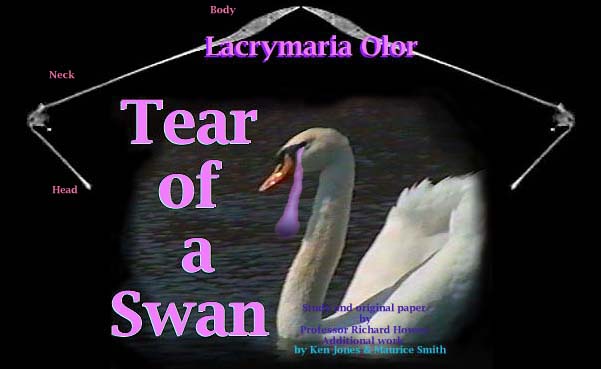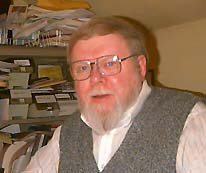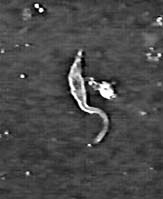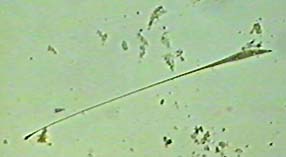

What creature on earth has the longest neck?
What creature will regenerate another head when the original one is cut off?
What creature can extend its neck over 7x its body length?
What creature feeds by ripping giant chunks out of other animals?
What creature exists invisible to the human eye?
There is but one living beast
matching these characteristics:
its name is Lacrymaria olor - (Latin for 'Tear of a Swan')!
One of the most unusual microscopic animals amongst the wide range of protozoans is Lacrymaria olor, a very small creature - typically 100 microns long, that lives in freshwater ponds. Its name means 'tear of a swan', which is an excellent and apt description of both its general shape, and one of its identifying traits; for this animal possess the ability to extend its head outwards by means of what looks like an elongating neck. And just as a swan is able to manipulate its neck in many directions, Lacrymaria is able to maintain the same type of agility over its extensibility.
 The following notes on this curious
creature have been drawn from a fabulous and detailed study by Professor Richard L. Howey, of
Laramie, Wyoming, (see portrait left) and is accompanied by images captured on
video by Ken Jones, a UK
amateur microscopist -
renowned for his high quality video films of microscopic forms.
Further references have been drawn from a newsletter of the Manchester Microscopical & Natural
History Society, edited by
Roy Winsby as an extraction from Professor Howey's original paper
and study.
The following notes on this curious
creature have been drawn from a fabulous and detailed study by Professor Richard L. Howey, of
Laramie, Wyoming, (see portrait left) and is accompanied by images captured on
video by Ken Jones, a UK
amateur microscopist -
renowned for his high quality video films of microscopic forms.
Further references have been drawn from a newsletter of the Manchester Microscopical & Natural
History Society, edited by
Roy Winsby as an extraction from Professor Howey's original paper
and study.
Lacrymaria, although
often mentioned in early books and papers on protozoa, seems to
have been little studied prior to the 20th century. An early
reference appears in a wonderful little publication called
Evenings at the Microscope, published by the Society for
promoting Christian Knowledge, London, 1859 - yet most of the
article, whilst providing an accurate and detailed observation of
the creature and its movements, gives little detail of its
lifestyle and morphology. The amateur
microscopist's pond-life bible 'Fresh-water Biology' (Ward &
Whipple), places the representative species to Müller
1786.
Professor Howey defines the Lacrymaria's
morphology as follows:-

Often described as having two macronuclei and a
single micronucleus, Professor Howey reports observing specimens
with one, two, three, four, five, and seven macronuclei,
"...although special reasons apply for those having more
than two". The body is covered with cilia, arranged in
spirals down the neck and along the body, providing a means of
locomotion. Cilia around the head appear longer and are in
bundles. The 'neck' itself is difficult to understand in terms of
its structure, but Professor Howey speculates that it probably
consists of microtubules and possibly myonemes.
 Lacrymaria olor has two contractile
vacuoles to regulate the osmotic pressure in the cell. One of
these is typically located in the posterior end of the cell, with the other at the
anterior end of the body near the beginning of the neck. Both the
body and neck usually contain crystals which show up strikingly
under polarized light; they are especially concentrated at the
posterior end of the cell.
Lacrymaria olor has two contractile
vacuoles to regulate the osmotic pressure in the cell. One of
these is typically located in the posterior end of the cell, with the other at the
anterior end of the body near the beginning of the neck. Both the
body and neck usually contain crystals which show up strikingly
under polarized light; they are especially concentrated at the
posterior end of the cell.
Culturing seems to be more successful when specimens are taken from different strains at different locations, suggesting that a 'genetic switch' may become triggered due to insufficient genetic diversity when only a single batch is cultivated from a single strain! Professor Howey describes his attempts to culture Lacrymaria olor (abridged here) as follows:-
"I found five specimens in a culture sample which I collected from Hutton Lake in the game preserve located about 15 miles south-west of Laramie. On earlier occasions, I had found a few specimens and both Bob Jenkins and I attempted to culture the organism with no success. However, this time, I was determined to establish cultures. Beginning with these five cells, I coaxed them along, making hundreds of cultures and trying dozens of different types of culture media.
This process was both tedious and aromatic as my long-suffering wife will attest. I tried making extracts of hay, wheat, cow dung, malted milk, alfalfa, lettuce, sheep dung, rice, and all kinds of combinations. Finally after a long period of trial and error combined with consultation of literature on various types of media used for culturing protozoa, I found a medium that has provided moderate success.
Now, I have quite a reliable method that
produces several hundred specimens in stable cultures which I
have been able to keep going for two years. The method is
reliable for me. Four other people have tried it, with only one
having good success, and the other three experiencing
difficulties with long term maintenance. I think I have finally
figured out why. Lacrymaria's sex life is, by our standards, a
bit strange. It not only does the old anti-arithmetic trick of
multiplying by dividing, it also, if it can find a mating type,
will conjugate and exchange genetic material. But this business
of mating types is a very peculiar business. As Margulis reports
on Paramecium, another Protozoa:-
Now, if there is no other mating type available, then Lacrymaria may simply start dividing up its own genetic material into six, eight, or more pieces and begin a process of repair and recombination. The mechanism is called autogamy. After this reorganization, the organism can then begin to reproduce again by division. Certain conditions obtain for autogamy to take place and the cells must still be healthy enough to undergo this radical repair process. If the conditions are not right, then the organism will reach a limit in terms of the number of times it can divide, and the culture will die out. What is intriguing is that there is apparently a genetic switch operative here. It functions rather like a counter and keeps track of the number of divisions. If there has been no new genetic material introduced by conjugation nor any reorganization of the genetic material by means of autogamy, then when the counter reaches its programmed limits, the cells die off.
Now, I was not looking for any such phenomenon when I started too culture Lacrymaria. However on three occasions, I had all of my cultures die off within a period of about two weeks, and on each occasion that involved 50 cultures. In the old cultures, there was no indication of viral infection, chemical contamination, or predation. This led me to the suspicion that Lacrymaria might have a 'genetic switch' such as the one which has been described for Paramecium.
 I
spent a summer collecting Lacrymaria from
lakes, rivers, ponds , streams, springs, and puddles. By
collecting specimens from a variety of locations, I was hoping to
obtain Lacrymaria with slightly different
genetic variations to provide different mating types. I found
specimens in six distinctly different environments and cultured
all of them. They flourished at first. However, after some months
two strains started to get smaller and smaller, a clear sign of
weakening. Four strains still survive along with several mixes.
The crossing of the different strains sometimes produces a new
hardier strain, but not always. In short, the other three people
who failed to have success with my culture method may have run
into a problem with a 'genetic switch' as a result of
insufficient genetic diversity."
I
spent a summer collecting Lacrymaria from
lakes, rivers, ponds , streams, springs, and puddles. By
collecting specimens from a variety of locations, I was hoping to
obtain Lacrymaria with slightly different
genetic variations to provide different mating types. I found
specimens in six distinctly different environments and cultured
all of them. They flourished at first. However, after some months
two strains started to get smaller and smaller, a clear sign of
weakening. Four strains still survive along with several mixes.
The crossing of the different strains sometimes produces a new
hardier strain, but not always. In short, the other three people
who failed to have success with my culture method may have run
into a problem with a 'genetic switch' as a result of
insufficient genetic diversity."
Some microscopic life-forms are able to go through reorganization of their cell structure to produce one or more protective 'casings' and go dormant: a process called encystment! This allows the organism to survive dehydration, heat, cold, oxygen loss, and some kinds of contamination. It is a complex and remarkable process, where years later, under the return of favourable conditions - the organism can reform itself and emerge from the cyst to take up life from where it left off: a kind of resurrection!
Professor Howey reports that he was able to get experimental evidence for encystment and excystment in Lacrymaria by letting the culture dry out completely, and then - after several months - adding new culture medium. In several cases, the 'resurrection' process was observed. Lacrymaria seem to go into a resting stage and sometimes into a cyst which is extraordinarily small and therefore almost impossible to trace.
Lacrymaria feed primarily on small ciliates, flagellates, and amoeba, although on occasion they will tear chunks out of larger ciliates for food. The feeding process appears a random process with the animal locating food by contacting a suitable supply with its "nose cone". Professor Howey reports that observing the feeding process can be very frustrating, with the Lacrymaria seemingly not well-equipped to identify its food consistently. This trait certainly seems to be true when I observed the video footage taken by Ken Jones.
One of the most incredible observations in
Professor Howey's paper was that the Lacrymaria was able
to regenerate a new head when the original one was cut off. The
professor ingeniously drew a home-made microscalpel across the
neck of a specimen, to discover that the head zipped away from
the body like a small powerful motor, whilst the wounded neck
sealed off almost immediately. Within minutes, regeneration had
begun, resulting in the growth of a new head in a very short
time; alas, the original head enjoyed a brief period of rapid
swimming (minutes) before ceasing motion and disintegrating.
You may wish to visit the Micscape Movie Section to see a longer video of Lacrymaria olor in far smoother detail.
All material is (c) copyright of Professor
Howey, Ken Jones, or Micscape. Please don't use it without asking
first!
If in doubt, check it out: we don't bite!
Notes: this article is a very summary one based on a far more
detailed study by Professor Howey.
The video footage was provided by Ken Jones
and was vastly superior to the somewhat poorer quality
replications shown in association with this article. This is due
to keeping file size down for web transmissions. All material
remains the copyright of the contributors. We have been able to
contact Professor Howey... who kindly consented to us reproducing
his study and observations here for you to share. His original
work has been edited slightly to optimise it for web retention.
Micscape thanks you greatly Professor, for this wonderful
contribution. Please contact me, Maurice
Smith, if anyone else can add further information about Lacrymaria
olor. Many thanks to Ken Jones, Roy Winsby, and Prof.
Richard L. Howey for their excellent personal and original work,
and their even greater commitment to the study of microscopic
life!
Please report any Web problems
or offer general comments to the Micscape Editor,
via the contact on current Micscape Index.
Micscape is the on-line monthly
magazine of the Microscopy UK web
site at Microscopy-UK